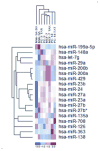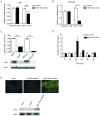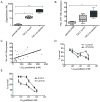miR-135a contributes to paclitaxel resistance in tumor cells both in vitro and in vivo
- PMID: 21552288
- PMCID: PMC3572709
- DOI: 10.1038/onc.2011.148
miR-135a contributes to paclitaxel resistance in tumor cells both in vitro and in vivo
Abstract
Cancer cell resistance to paclitaxel continues to be a major clinical problem. In this study, we utilized microRNA (miRNA) arrays to screen for differentially expressed miRNAs in paclitaxel-resistant cell lines established in vitro. We observed concordant upregulation of miR-135a in paclitaxel-resistant cell lines representing three human malignancies. Subsequently, the role of miRNA-135a was evaluated in an in vivo model of paclitaxel resistance. In this model, mice were inoculated subcutaneously with a non-small cell lung carcinoma cell line and treated with paclitaxel for a prolonged period. In paclitaxel-resistant cell lines, established either in vitro or in vivo, blockage of miR-135a sensitized resistant cell lines to paclitaxel-induced cell death. We further demonstrated a correlation between paclitaxel response and miR-135a expression in paclitaxel-resistant subclones that were established in vivo. The paclitaxel-resistant phenotype of these subclones was maintained upon retransplantation in new mice, as shown by decreased tumor response upon paclitaxel treatment compared with controls. Upregulation of miR-135a was associated with reduced expression of the adenomatous polyposis coli gene (APC). APC knockdown increased paclitaxel resistance in parental cell lines. Our results indicate that paclitaxel resistance is associated with upregulation of miR-135a, both in vitro and in vivo, and is in part determined by miR-135a-mediated downregulation of APC.
Conflict of interest statement
The authors declare no conflict of interest.
Figures









Similar articles
-
miR-17-5p downregulation contributes to paclitaxel resistance of lung cancer cells through altering beclin1 expression.PLoS One. 2014 Apr 22;9(4):e95716. doi: 10.1371/journal.pone.0095716. eCollection 2014. PLoS One. 2014. PMID: 24755562 Free PMC article.
-
miR-30a-5p enhances paclitaxel sensitivity in non-small cell lung cancer through targeting BCL-2 expression.J Mol Med (Berl). 2017 Aug;95(8):861-871. doi: 10.1007/s00109-017-1539-z. Epub 2017 May 9. J Mol Med (Berl). 2017. PMID: 28487996
-
MiR-1204 sensitizes nasopharyngeal carcinoma cells to paclitaxel both in vitro and in vivo.Cancer Biol Ther. 2015;16(2):261-7. doi: 10.1080/15384047.2014.1001287. Cancer Biol Ther. 2015. PMID: 25756509 Free PMC article.
-
miR-339-5p downregulation contributes to Taxol resistance in small-cell lung cancer by targeting α1,2-fucosyltransferase 1.IUBMB Life. 2017 Nov;69(11):841-849. doi: 10.1002/iub.1679. Epub 2017 Sep 22. IUBMB Life. 2017. PMID: 28940895
-
Paclitaxel exposure downregulates miR-522 expression and its downregulation induces paclitaxel resistance in ovarian cancer cells.Sci Rep. 2020 Oct 7;10(1):16755. doi: 10.1038/s41598-020-73785-8. Sci Rep. 2020. PMID: 33028939 Free PMC article.
Cited by
-
miR-135 family members mediate podocyte injury through the activation of Wnt/β-catenin signaling.Int J Mol Med. 2015 Sep;36(3):669-77. doi: 10.3892/ijmm.2015.2259. Epub 2015 Jun 24. Int J Mol Med. 2015. PMID: 26134897 Free PMC article.
-
miR-135 regulated breast cancer proliferation and epithelial-mesenchymal transition acts by the Wnt/β-catenin signaling pathway.Int J Mol Med. 2019 Apr;43(4):1623-1634. doi: 10.3892/ijmm.2019.4081. Epub 2019 Jan 29. Int J Mol Med. 2019. PMID: 30720046 Free PMC article.
-
miR-15b modulates multidrug resistance in human osteosarcoma in vitro and in vivo.Mol Oncol. 2017 Feb;11(2):151-166. doi: 10.1002/1878-0261.12015. Epub 2016 Oct 24. Mol Oncol. 2017. PMID: 28145098 Free PMC article. Clinical Trial.
-
High-throughput sequencing of pituitary and hypothalamic microRNA transcriptome associated with high rate of egg production.BMC Genomics. 2017 Mar 23;18(1):255. doi: 10.1186/s12864-017-3644-3. BMC Genomics. 2017. PMID: 28335741 Free PMC article.
-
MiR-26a inhibits proliferation and migration of breast cancer through repression of MCL-1.PLoS One. 2013 Jun 4;8(6):e65138. doi: 10.1371/journal.pone.0065138. Print 2013. PLoS One. 2013. PMID: 23750239 Free PMC article.
References
-
- Anand S, Penrhyn-Lowe S, Venkitaraman AR. AURORA-A amplification overrides the mitotic spindle assembly checkpoint, inducing resistance to Taxol. Cancer Cell. 2003;3:51–62. - PubMed
-
- Aoki K, Taketo MM. Adenomatous polyposis coli (APC): a multi-functional tumor suppressor gene. J Cell Sci. 2007;120:3327–35. - PubMed
-
- Blower PE, Verducci JS, Lin S, Zhou J, Chung JH, Dai Z, et al. MicroRNA expression profiles for the NCI-60 cancer cell panel. Mol Cancer Ther. 2007;6:1483–91. - PubMed
-
- Chu Q, Vincent M, Logan D, Mackay JA, Evans WK. Taxanes as first-line therapy for advanced non-small cell lung cancer: a systematic review and practice guideline. Lung Cancer. 2005;50:355–74. - PubMed
-
- Cleveland WS. Robust locally weighted regression and smoothing scatter plots. J Amer Statist Assoc. 1979;74:829–836.
Publication types
MeSH terms
Substances
Grants and funding
LinkOut - more resources
Full Text Sources
Other Literature Sources

